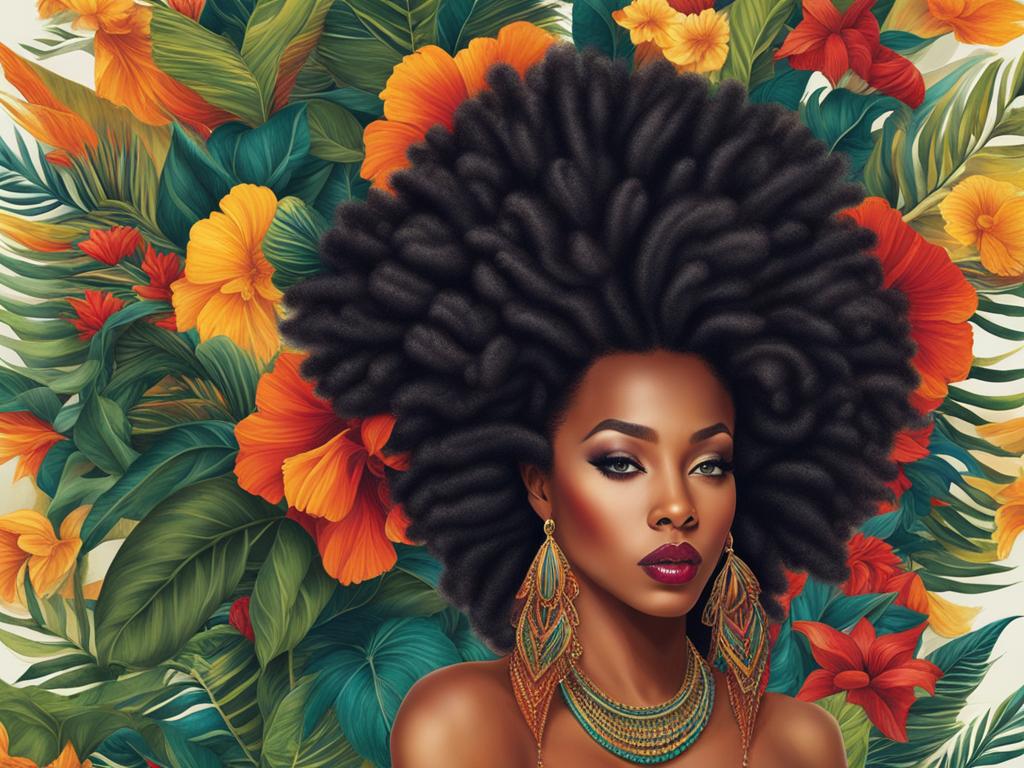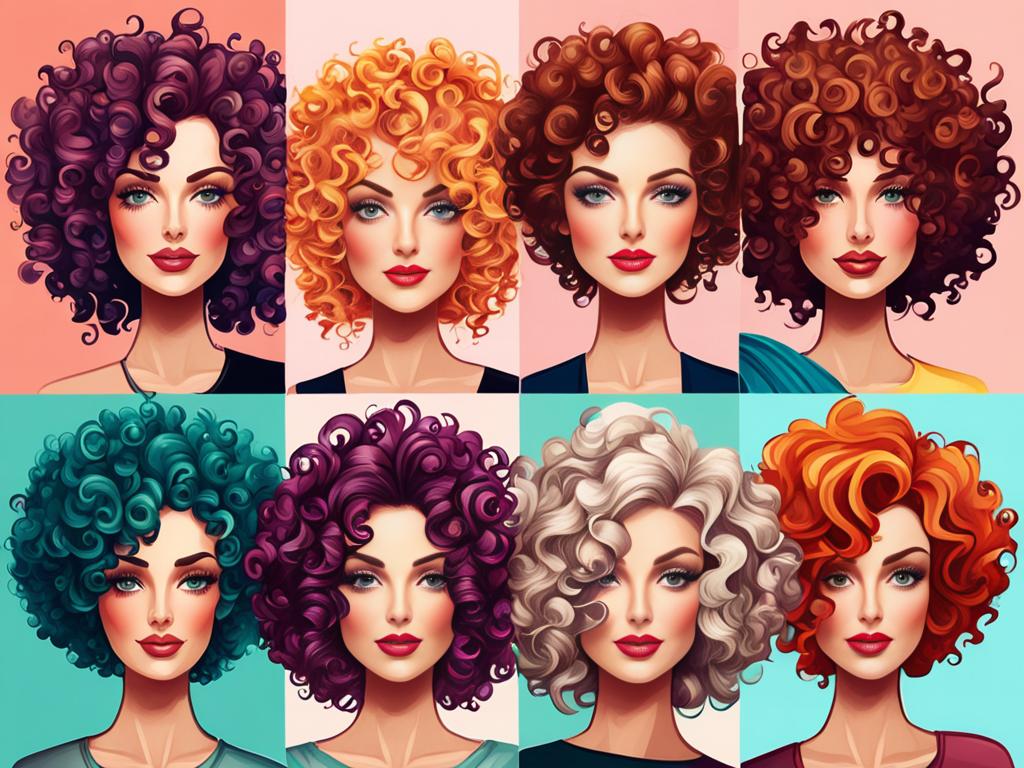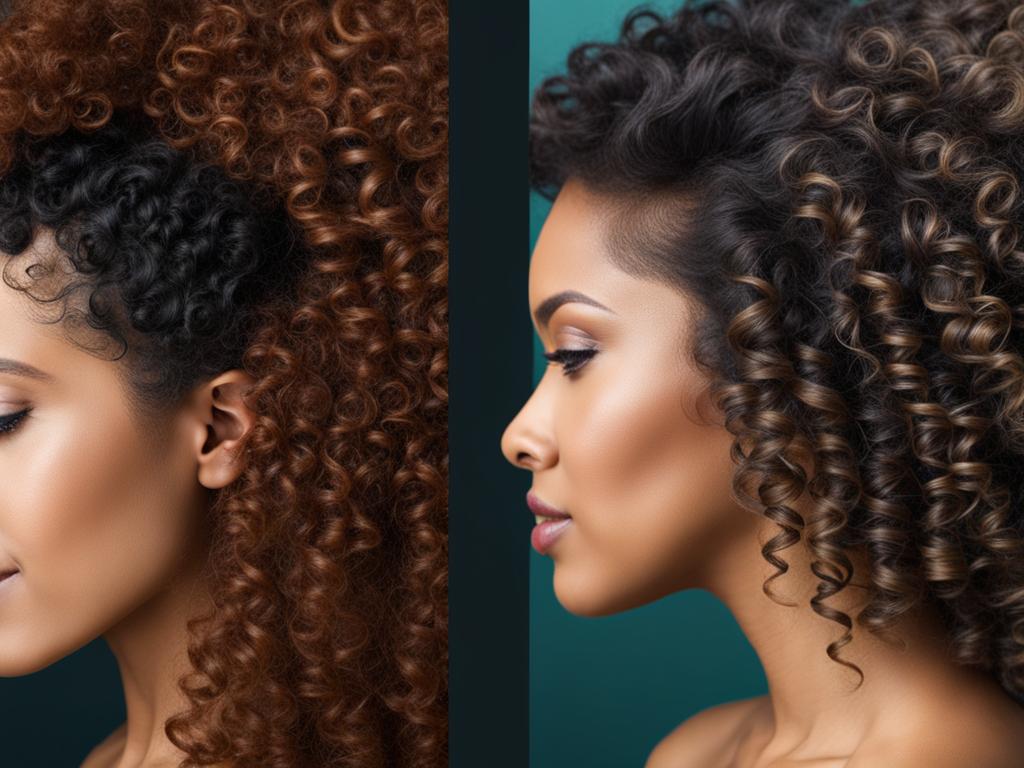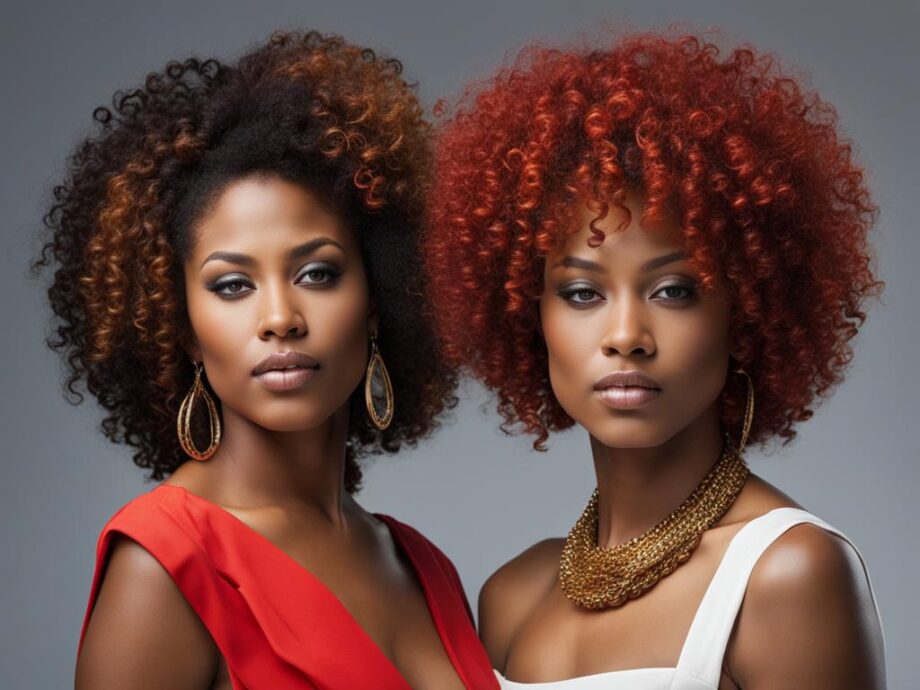When it comes to hair types, it’s essential to understand the differences between kinky hair and curly hair. Although these two hair types may seem similar, they have unique characteristics and require different care routines. Understanding your hair type is crucial to maintain its health, hydration, and vibrancy.
Kinky hair is a hair type that has an “S” or “Z” shape curl pattern and tends to be tightly coiled. On the other hand, curly hair, as the name suggests, has a curl pattern that ranges from loose “S” curls to tight “C” curls. One of the significant differences between kinky hair and curly hair is their texture and curl pattern.
In this article, we will dive deeper into understanding the key differences between kinky hair and curly hair. We will explore different hair types, care routines, managing techniques, and styling tips to embrace the beautiful natural texture of your hair.
Key Takeaways
- Kinky hair has a tightly coiled “S” or “Z” shape curl pattern, while curly hair has a range of curl patterns from loose “S” curls to tight “C” curls.
- The texture and curl pattern of kinky hair and curly hair are distinct. Understanding your hair type is essential for proper care and styling.
- We will go into detail regarding the care and styling of both kinky hair and curly hair throughout the article.
Understanding Kinky Hair
If you have kinky hair, you know that it requires unique care to stay healthy and beautiful. Kinky hair is characterized by tight, coily curls that can range from Type 4A, which has a defined curl pattern, to Type 4C, which is tightly coiled and can be more challenging to manage.

| Type | Curl Pattern | Features |
|---|---|---|
| 4A | Tightly coiled S-shaped coils | Defined curl pattern, soft and fine texture |
| 4B | Zigzag-shaped coils | Tight kinks, less defined curl pattern, less shine |
| 4C | Tightly coiled and densely packed coils | Less defined curl pattern, more shrinkage, fragile strands |
If you have kinky hair, it’s important to avoid drying it out with harsh shampoos and frequent washes. Instead, use a gentle sulfate-free shampoo and conditioner, and consider co-washing to keep your hair moisturized and healthy. Additionally, regular deep conditioning treatments can help to strengthen and nourish your hair.
When it comes to styling, protective styles like braids, twists, and bantu knots can help to minimize breakage and promote growth. Embrace your natural texture by using styling products specifically designed for kinky hair, like butters, oils, and creams.
Overall, managing kinky hair requires patience, gentleness, and a commitment to proper care and maintenance. By adopting healthy hair habits and embracing your natural beauty, you can rock your kinky curls with confidence!
Understanding Curly Hair
Curly hair can sometimes be quite challenging to manage, especially if you don’t know how to care for it properly. In this section, we will take a closer look at the different types of curly hair that exist and provide some valuable insights on how to manage and care for each type.
Types of Curly Hair
Curly hair comes in several different types, ranging from loose waves to tight, spiraled coils. The most common types of curly hair are:
- Type 2A: Fine and thin hair with loose S-shaped waves
- Type 2B: Medium-textured hair with more defined S-shaped waves and more volume
- Type 3A: Loosely-defined curls with a diameter similar to a piece of sidewalk chalk
- Type 3B: Springy, ringlets with a diameter similar to a marker
- Type 3C: Tight corkscrew curls with a diameter similar to a pencil or straw
To determine your curly hair type, examine the texture, diameter, and shape of your curls. This knowledge will help you select the appropriate hair products and styling techniques for your unique hair texture and needs.

Caring for Curly Hair
Caring for curly hair requires a bit of effort, but it’s definitely worth it in the end. Here are some tips to help you manage and care for your curls:
- Choose hair products that are specifically formulated for curly hair
- Avoid harsh chemicals, such as sulfates and alcohol, which can damage and dry out curly hair
- Moisturize regularly to keep your curls hydrated and healthy
- Use a wide-toothed comb or your fingers to detangle your hair, starting from the bottom and working your way up to avoid damaging your curls
- Avoid using heat styling tools, or use them sparingly and always with a heat protectant spray
Caring for curly hair can be quite rewarding, as it allows you to embrace your unique hair texture and enhance its natural beauty. With the right care and styling techniques, you can maintain healthy, vibrant curls that are the envy of everyone around you.
Texture Differences between Kinky Hair and Curly Hair
Kinky hair and curly hair may seem similar, but upon closer inspection, they have distinct differences in texture. When discussing hair texture, individuals refer to the shape and pattern of their hair strands. Kinky hair has a tighter, more coiled shape, while curly hair tends to have a looser, more defined curl pattern. Furthermore, kinky hair tends to be more dense and coarse, while curly hair is often finer and softer to the touch.

Kinky Hair Texture
Kinky hair has a zigzag pattern and tight coils, with a distinct “Z” shape. This hair type may look and feel rough to the touch, but it has remarkable strength and elasticity. Its unique structure also makes it highly prone to knots and tangles, which can lead to breakage if not managed properly.
Tip: If you have kinky hair, consider using a detangling brush or a wide-tooth comb to gently work through knots and prevent breakage. Additionally, use moisturizing products and avoid using heat styling tools, which can damage the hair.
Curly Hair Texture
Curly hair has a distinct spiral or “S” shape, with varying degrees of curl patterns. From loose waves to tight ringlets, curly hair can be very individualized in terms of shape and texture. Curly hair can be prone to frizz and dryness, but with proper care, it can be incredibly defined and bouncy.
Tip: If you have curly hair, apply styling products while your hair is still wet to enhance definition and reduce frizz. Use a diffuser attachment when blow-drying your hair, as it will help maintain your curls’ shape without pulling them out of position.
The Bottom Line
Understanding the texture differences between kinky hair and curly hair can help you tailor your hair care and styling regimen to your unique needs. Whether you have kinky hair or curly hair, bear in mind that no hair type is better than the other. Embrace your natural texture and learn how to work with it to achieve your desired look.
Styling Tips for Kinky Hair vs Curly Hair
Once you understand the unique characteristics of your hair type, it’s time to explore different styling options. Whether you prefer wearing your curls loose or up in a protective style, there are countless ways to showcase the beauty of your hair. Keep reading for some styling tips tailored specifically for kinky hair vs curly hair.
Styling Tips for Kinky Hair
Kinky hair can be styled in many cute and trendy ways. Here are some tips to help you achieve the perfect look:
- Experiment with accessories like headbands, clips, and bows to add interest to your hairstyles.
- Try a protective style like braids or twists to keep your hair healthy and promote growth.
- Use a wide-tooth comb or your fingers to detangle your hair, and avoid using fine-tooth combs or brushes which can damage the hair and create frizz.
- Moisturize your hair daily to prevent breakage and maintain its natural luster.
Follow these tips to keep your kinky hair looking fabulous every day.
Styling Tips for Curly Hair
Curly hair can be versatile and fun to style. Here are some tips to help you achieve the perfect look:
- Incorporate a diffuser when using a hairdryer to help define and enhance your curls.
- Try a messy bun or loose side braid for a quick and effortless hairstyle.
- Use a light styling cream or gel to hold your curls in place without weighing them down.
- Avoid touching your curls too often as this can create frizz and disrupt your hairstyle.
Follow these tips to keep your curly hair looking fabulous every day.
Remember, no matter what type of hair you have, the most important thing is to embrace your natural beauty. Now that you have some styling tips in your arsenal, try experimenting to find the looks that work best for you.
Caring for Kinky Hair vs Curly Hair
The care requirements for kinky hair and curly hair are unique and require different approaches to maintain their health and beauty. Here are some essential tips and strategies to help you care for your hair type:
- Stay hydrated: Both kinky and curly hair tend to be dry, so it’s crucial to keep your hair hydrated. Drink plenty of water and use a moisturizing shampoo and conditioner.
- Avoid overwashing: Washing your hair too often can strip it of its natural oils, causing it to become dry and brittle. Kinky hair can be washed once a week, while curly hair can be washed more frequently, up to three times a week.
- Maintain your ends: Kinky hair and curly hair both require regular trimming to prevent split ends. Trim your ends every three to four months to promote healthy growth.
- Use the right products: Kinky hair and curly hair need different products to keep them healthy and manageable. Use products specifically designed for your hair type, and avoid using products with harsh chemicals.
- Minimize heat styling: Both kinky and curly hair are prone to heat damage, so it’s essential to minimize the use of heated styling tools. Instead, opt for protective styles like braids, twists, or bantu knots.
By following these tips, you can maintain the health, hydration, and overall well-being of your kinky or curly hair.
Determining Your Hair Type
Understanding your hair type is crucial to maintaining its health and beauty. By correctly identifying your hair texture, you can tailor your hair care routine and styling techniques to best suit your unique needs.
So, how can you determine your hair type? Let’s start by examining the characteristics of kinky and curly hair:
| Kinky Hair | Curly Hair | |
|---|---|---|
| Texture: | Tightly coiled and springy | S-shaped or spiral |
| Width: | Fine, medium or thick | Fine, medium or thick |
| Pores: | May appear closed due to pronounced curl pattern | Appears open and semi-circular |
| Shrinkage: | High shrinkage due to tightly coiled hair | Moderate shrinkage due to S-shape pattern |
| Curl Definition: | Curls may be less defined due to tightly coiled hair | Curls are generally well-defined |
By carefully examining your hair’s texture, width, pore size, shrinkage, and curl definition, you can determine whether you have kinky hair or curly hair. Remember, hair types can vary, so don’t worry if your hair doesn’t exactly fit into one category or the other.
To further determine your hair type, you can take a strand test. Take a single strand of hair and stretch it gently between your fingers. If your hair breaks easily and doesn’t stretch much, you likely have Type 4 kinky hair. If your hair stretches and returns to its original length without breaking, you may have Type 2 or Type 3 curly hair.
By taking the time to determine your hair type and learning about its unique characteristics, you can confidently care for and style your hair, enhancing its natural beauty.
Conclusion
Understanding the difference between kinky hair and curly hair is crucial for proper care and management. Each hair type has unique characteristics and requires specific attention to maintain its health and beauty.
By determining your hair type and following the tips provided in this article, you can embrace and enhance the natural beauty of your hair texture. Remember to stay hydrated and nourished with proper care and styling techniques.
Whether you have kinky hair or curly hair, show it off with confidence and pride. Let your hair be a reflection of your unique personality and style.
Thank you for reading and we hope you found this article informative and helpful in understanding the differences between kinky hair and curly hair.
FAQ
What are the key differences between kinky hair and curly hair?
Kinky hair and curly hair differ in their texture and shape. Kinky hair has a tightly coiled pattern with less defined curls, while curly hair has looser, more defined curls. Additionally, kinky hair tends to be more fragile and prone to shrinkage compared to curly hair.
What are the different types of kinky hair?
Kinky hair is categorized into three types: Type 4A, Type 4B, and Type 4C. Type 4A hair has a defined S-shape pattern, Type 4B hair has a zigzag or Z-shape pattern, and Type 4C hair has a tight, densely packed coil pattern.
What are the different types of curly hair?
Curly hair is classified into different types based on its texture. Type 2A hair has loose, wavy curls, Type 2B hair has more prominent waves, Type 3A hair has defined S-shaped curls, Type 3B hair has tighter, ringlet-like curls, and Type 3C hair has corkscrew-shaped curls.
How can I determine if my hair is kinky or curly?
You can determine your hair type by examining its texture and pattern. Kinky hair tends to have tight, springy coils, while curly hair has looser, more defined curls. Pay attention to the natural shape and behavior of your hair to determine if it falls under the kinky or curly category.
How should I care for kinky hair?
Kinky hair requires regular moisturization, gentle handling, and protective styling to maintain its health. Use sulfate-free shampoos, deep condition regularly, avoid heat styling, and protect your hair with satin or silk scarves or bonnets while sleeping.
How should I care for curly hair?
Curly hair needs proper hydration, regular conditioning, and careful detangling. Use products specifically designed for curly hair, avoid brushing when dry, and incorporate a leave-in conditioner or curl-enhancing cream to define and maintain the shape of your curls.
What are some styling tips for kinky hair?
Styling kinky hair can involve twist-outs, braid-outs, or wash-and-gos to enhance the natural curl pattern. Use moisturizing products, avoid excessive manipulation, and consider protective styles like braids or twists to minimize breakage and promote hair growth.
What are some styling tips for curly hair?
Styling curly hair can involve diffusing, scrunching, or using gel to enhance the curl definition. Experiment with different techniques to find what works best for your hair type. Avoid touching or fussing with your curls too much to maintain their shape.
How can I manage shrinkage in kinky hair?
Shrinkage is a common characteristic of kinky hair. To manage shrinkage, stretch your hair with twist-outs, braid-outs, or other stretching techniques. You can also use heat styling tools like a blow dryer with a diffuser attachment or a flat iron to temporarily elongate your hair.
Can I use the same products for kinky and curly hair?
While there may be some overlap, it’s generally best to use products specifically formulated for your hair type. Kinky hair often requires heavier, more moisturizing products, while curly hair may benefit from lighter, curl-enhancing products. Experiment and find what works best for your unique hair.
